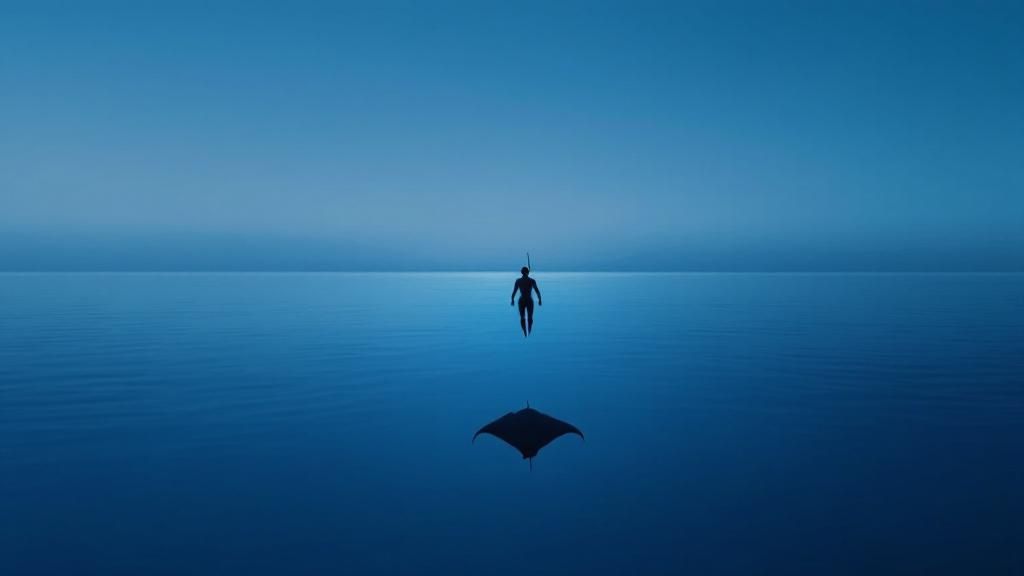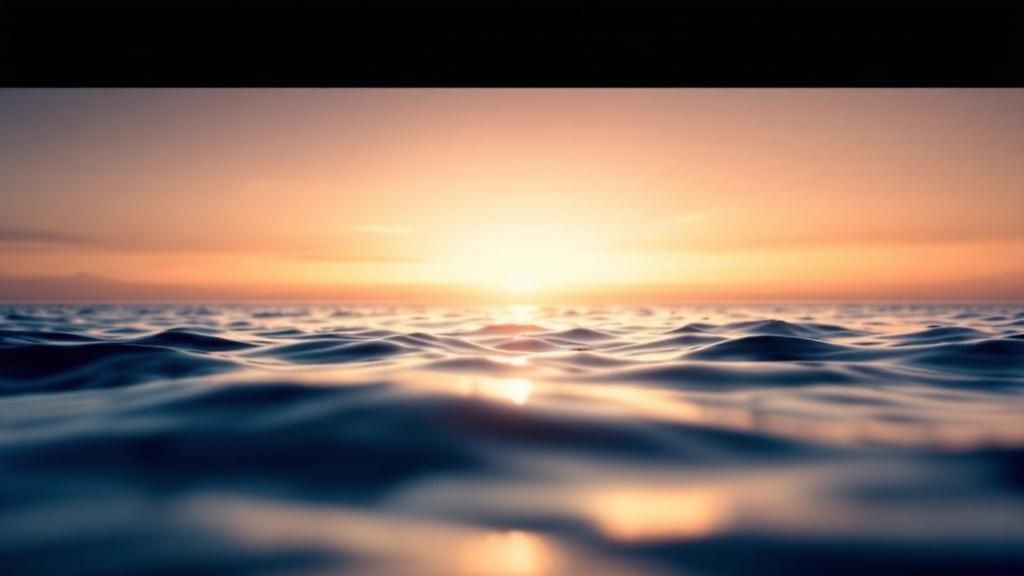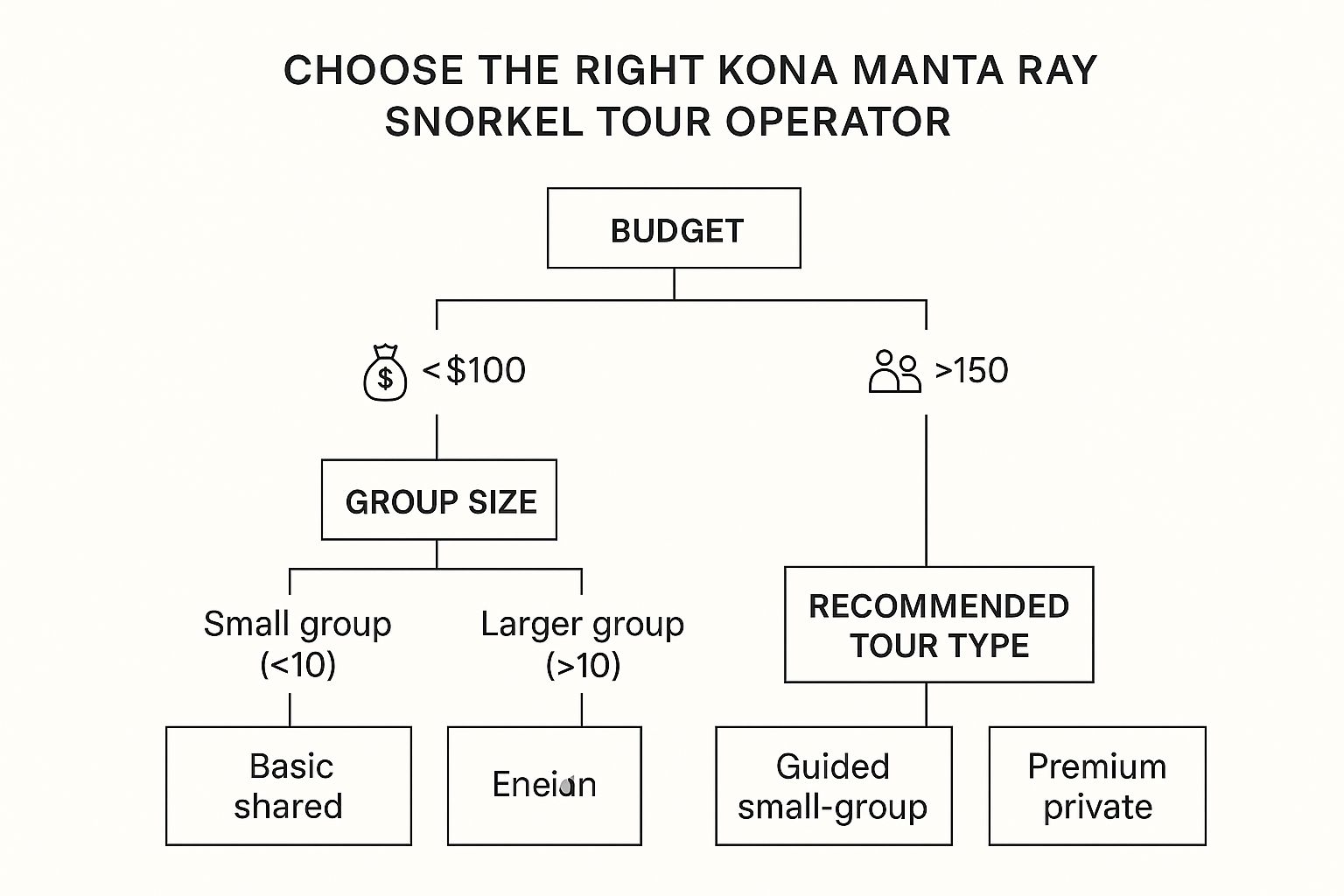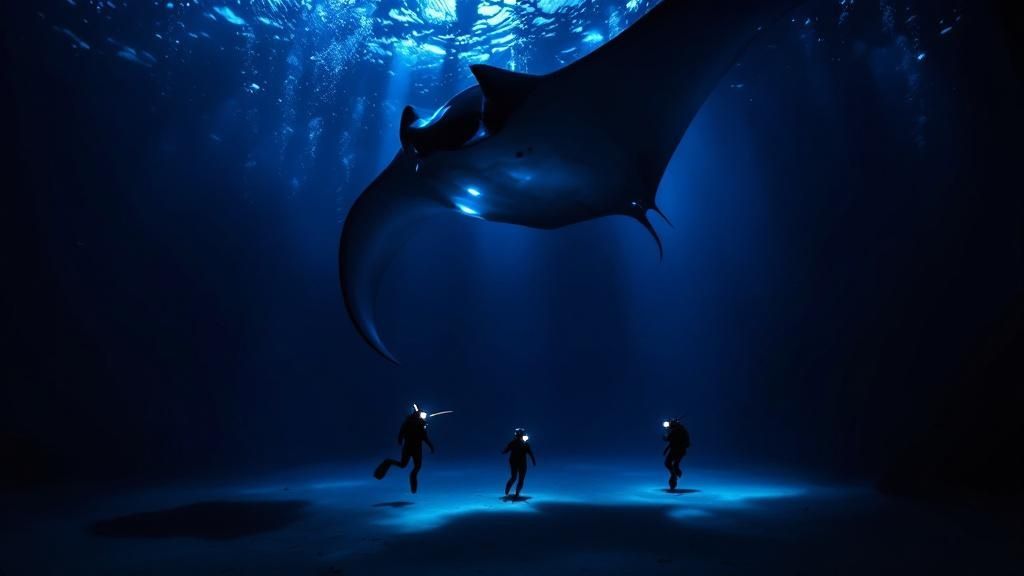Best Manta Ray Snorkel Kona Tours: Expert Guide & Tips
- Byron
- Jun 7
- 13 min read
Why Kona Leads The World In Manta Ray Encounters

Kona, Hawaii, is more than just a stunning vacation destination; it's the manta ray encounter capital of the world. The Big Island's unique geography creates the perfect environment for these gentle giants, making it the most reliable place to see them. But what makes Kona so special?
The Perfect Underwater Playground
The volcanic coastline offers a series of sheltered bays, with deep ocean waters just offshore. This creates a natural underwater amphitheater, an ideal habitat for manta rays to flourish. Consistent water temperatures and predictable weather further enhance this perfect environment.
The Allure of Light: A Symbiotic Relationship
Kona's manta ray encounters are made even more magical by the fascinating interplay of nature and human activity. Resorts along the shoreline position lights that shine into the water, unintentionally creating a nightly feast for the manta rays. These lights attract plankton, the manta ray's main food source, making these illuminated areas reliable feeding grounds.
This readily available food source brings manta rays to these spots night after night. Places like Manta Village and Manta Heaven are now famous for their consistent manta ray sightings. This has made Kona a paradise for both the manta rays and the people who come to see them.
Kona: A Manta Ray Hotspot
Manta ray snorkeling in Kona, Hawaii is known worldwide for its high success rate. The Kona Coast boasts an impressive 80% to 90% sighting success rate year-round. This draws approximately 80,000 participants annually, making it one of the most sought-after snorkeling experiences. You can find more statistics here: Manta Ray Snorkel Kona: Unforgettable Hawaii Marine Tours. This isn't just clever marketing; it’s a testament to the unique environment and responsible human interaction.
The Impact of Responsible Tourism
Interested in learning more? Check out this post: Best Time To See Manta Rays In Kona
Kona's manta ray tourism demonstrates the positive impact of responsible practices. Careful tour management and strategic lighting have created sustainable feeding patterns for healthy manta ray populations. This allows visitors to enjoy these breathtaking encounters while contributing to the well-being of these amazing animals, creating a successful model of sustainable tourism where conservation and commerce thrive together.
The Science Behind Those Incredible Success Rates

The remarkable frequency of manta ray sightings in Kona isn't by chance. It's a captivating blend of natural behaviors and human ingenuity. This unique combination creates a thriving environment for these gentle giants, offering visitors an almost guaranteed encounter.
The Plankton Connection: A Microscopic Feast
Understanding why manta rays gather in specific Kona locations begins with the microscopic world of plankton. These tiny organisms, the base of the marine food web, are crucial to the manta ray's diet. Plankton are drawn to light, a behavior called phototaxis. This creates concentrated pockets of food, attracting filter feeders like manta rays.
Artificial Reefs of Light: Mimicking Nature's Bounty
This is where human innovation comes in. The resorts along the Kona coast, with their underwater lights, have unintentionally created artificial feeding grounds. These lights mimic the natural draw of plankton to moonlight and starlight, intensifying the effect and creating denser concentrations of these tiny organisms. This provides predictable feeding opportunities for the manta rays, who have learned to associate these illuminated areas with plentiful food.
This practice has established reliable manta ray viewing spots. The consistent sightings aren't just due to favorable conditions but also the strategic use of underwater lighting. Resorts shine lights into the water, attracting plankton, the manta rays' primary food source. This has turned areas like Manta Village and Manta Heaven into feeding grounds, increasing the likelihood of encounters. Learn more about this phenomenon: Manta Ray Kona Snorkel. This reliable food source makes manta ray snorkel Kona experiences predictable, attracting visitors worldwide.
A Delicate Balance: Tourism and Conservation
This mutually beneficial relationship goes beyond feeding patterns. Responsible tourism, including careful tour management, contributes to the success of manta ray encounters. By limiting the number of boats and snorkelers, these practices minimize disruptions to the manta rays’ natural behavior.
Evolved Behaviors: Seeking Out Light and Food
Manta rays, with their large brains, have adapted to take advantage of these concentrated food sources. Their highly developed senses allow them to detect areas of abundant plankton, making the illuminated Kona waters a predictable and rewarding feeding ground. This predictable behavior significantly increases the chance of sightings during manta ray snorkel Kona tours.
A Win-Win Situation: Sustainable Tourism in Action
The combination of natural behaviors, human innovation, and responsible tourism has created a sustainable model for manta ray encounters in Kona. This balance benefits both the local economy and the manta ray population, ensuring these magnificent creatures thrive while providing unforgettable experiences for visitors. This delicate balance ensures the long-term health of the manta ray population while supporting the local tourism industry.
Manta Village Vs Manta Heaven: Choosing Your Spot
Choosing the right manta ray snorkel Kona location can significantly impact your experience. This section compares two popular Kona sites: Manta Village at Garden Eel Cove and Manta Heaven at Keauhou Bay. Each offers unique advantages depending on the weather, your comfort in the water, and the kind of encounter you're looking for.
Depth and Accessibility: Key Considerations
Manta Village is generally shallower, averaging 30-40 feet deep. This makes it a great option for less experienced snorkelers or those who prefer shallower water. Manta Heaven, situated in a deeper bay, often reaches depths of 50-60 feet. While this deeper water can offer breathtaking views of larger manta rays, it might be less suitable for beginners.
Seasonal Factors: Timing Your Visit
Both locations offer excellent viewing during the calmer summer months. However, during winter, when Kona's southern coastline can be rough, Manta Heaven, sheltered within Keauhou Bay, often remains calm. This makes it a preferred choice when ocean conditions are less predictable. Manta Village, being more exposed, can be challenging in choppy water.
Choosing the Right Tour Operator
Selecting the right tour operator is crucial for a successful manta ray experience. Consider factors like group size, budget, and the level of personalized service you desire. The infographic below provides a helpful decision-making guide based on these factors, recommending tour types ranging from basic shared experiences to premium private tours.

This infographic illustrates how matching your budget and group size with the right tour type can enhance your experience. Budget-conscious travelers comfortable in larger groups may find basic shared tours a good fit. Those seeking a more personalized experience in smaller groups might prefer guided tours. For an exclusive experience, premium private tours offer customized service and privacy.
To further assist in your decision-making process, the following table summarizes key differences between Manta Village and Manta Heaven.
Manta Village vs Manta Heaven: Complete Comparison
Feature | Manta Village (Garden Eel Cove) | Manta Heaven (Keauhou Bay) |
|---|---|---|
Average Depth | 30-40 feet | 50-60 feet |
Best Conditions | Calm summer months | Year-round, especially calmer in winter due to bay's protection |
Snorkeler Level | Suitable for all levels | Better for intermediate to advanced snorkelers due to depth |
Accessibility | More exposed to open ocean | Sheltered within the bay |
This table highlights the key differences between the two locations. Manta Village, with its shallower depth, is generally more accessible. Manta Heaven, while deeper, offers greater protection from rough seas during the winter months. Considering these factors can ensure a more enjoyable experience.
Backup Locations and Adaptability
While Manta Village and Manta Heaven are the primary locations, experienced operators often have backup spots like Makako Bay or other areas off the Kona coast. This flexibility is essential, especially in changing weather conditions. Adaptable operators monitor conditions and adjust plans as needed. This ensures the best possible viewing experience, regardless of the immediate environment.
Finding The Perfect Tour For Your Adventure Style
Planning a manta ray snorkel adventure in Kona? With so many tour operators, choosing the right one can be tricky. This guide, drawing on feedback from thousands of participants, helps you navigate the options and find the perfect fit.
Vessel Variety: From Intimate Encounters to Luxurious Comfort
Tour boats come in all shapes and sizes, from small, intimate vessels to spacious, luxurious catamarans. Smaller boats get you closer to the action, creating a more intimate experience. Larger catamarans offer added comfort with amenities like heated freshwater showers and restrooms. Think about what matters most to you – an up-close encounter or a more relaxed, amenity-rich experience?
Group Size: A Big Impact on Your Experience
The number of people on your tour can significantly impact your manta ray encounter. Smaller groups offer more personalized attention from guides and a less crowded viewing area. Larger groups can be more budget-friendly, but might feel less personal and could limit your interaction with the manta rays.
Timing: Sunset, Evening, or Under the Stars?
Departure times play a key role in shaping your experience. Sunset tours offer stunning views of Kona's coastline bathed in golden light. Night tours focus exclusively on the manta ray experience under the starlit sky. Some operators also offer early evening tours, blending daylight and nighttime viewing.
Package Details: What's Included in Your Tour?
Tour packages vary widely in what they offer. Some provide basic snorkel gear, while others include wetsuits, flotation devices, and even underwater photography services. Review each package carefully to understand exactly what's included and factor that into your decision. For a more detailed breakdown, check out our Manta Ray Snorkel Kona: Your Complete Adventure Guide.
Key Questions to Ask Before You Book
Before booking, ask operators about their experience, safety protocols, group size limits, and weather contingency plans. Reputable operators prioritize safety, provide detailed briefings, and have backup plans in case of unexpected weather.
Red Flags: What to Watch Out For
Avoid operators who overcrowd their boats, skip safety briefings, or lack experience. Negative reviews and consistently low manta ray sighting rates are also warning signs. Research reviews and ask questions to avoid disappointment.
Evening vs. Night Tours: Choosing Your Comfort Level
Evening tours provide a gentler introduction to night snorkeling, ideal for families with young children or those nervous about entering the water in darkness. Night tours maximize your chances of witnessing the manta rays feeding under the underwater lights. Choose the option that best suits your comfort level and expectations.
Comparing Tour Options: A Quick Guide
To help you compare the different tours available, we've put together a handy table:
Kona Manta Ray Tour Options: What To Expect Comprehensive comparison of tour types, durations, and features to help you choose the perfect manta ray adventure
Tour Type | Duration | Group Size | Key Features | Best For |
|---|---|---|---|---|
Basic Shared | 1.5-2 hrs | 10-20 | Snorkel gear, basic briefing | Budget travelers, larger groups |
Guided Small Group | 2-2.5 hrs | 6-10 | Wetsuits, flotation devices, guide | Personalized experience, smaller groups |
Premium Private | 2.5-3 hrs | 2-6 | Underwater photography, private guide | Exclusive experience, families |
This table provides a general overview of what to expect from different manta ray snorkel tour types in Kona. Remember that specifics can vary between operators, so always double-check the tour description.
By carefully considering your preferences and doing your research, you can find the perfect manta ray snorkel tour in Kona for an unforgettable adventure. For more detailed information, visit our Manta Ray Snorkel Kona: Your Complete Adventure Guide.
Your First Manta Ray Encounter: What Really Happens

A manta ray snorkel adventure in Kona is truly special. This guide will walk you through what to expect from beginning to end, ensuring you're prepared for an unforgettable meeting with these gentle giants.
From Boat to Briefing: Getting Started
Your journey usually begins with a boat trip to a prime viewing location, often Manta Village or Manta Heaven. During the ride, your crew will conduct a thorough safety briefing. This important session covers how to interact respectfully with the manta rays and how to ensure a safe snorkeling experience.
Entering the Water: A Magical Moment
Once you arrive, you'll enter the water, usually positioned near a specially designed light board. These boards attract plankton, the manta rays' main food source. The lights create a perfect spot for observing these graceful creatures feeding, giving you an up-close view. You might be interested in: Manta Ray Snorkel Kona: Top Tips & Must-See Spots.
Observing the Manta Rays: A Ballet of Giants
Manta rays are incredibly elegant swimmers. They move through the water with a captivating fluidity. Their wingspans can reach an impressive 12 feet, creating a dramatic display as they glide and circle in the illuminated water. Their size and agility are truly amazing.
Common Concerns: Water Temperature and Visibility
First-time snorkelers often ask about water temperature and visibility. The water is typically comfortable. However, a wetsuit or wetsuit top is often suggested for extra warmth, especially at night. Visibility depends on conditions, but it's usually good enough for clear views of the manta rays.
Staying Calm and Comfortable: Tips for Success
Relax and breathe evenly while floating on the surface for a truly enjoyable experience. Focus on the incredible scene unfolding below, and absorb the wonder of the moment. Remember, manta rays are gentle and curious. They might even come closer for a better look at you.
Photography or Mindfulness: Choosing Your Focus
You'll likely want to take photos or videos of this unique experience. But don't let that distract you from simply enjoying the encounter. While underwater photography can be fun, try to spend some time just watching these majestic creatures and experiencing the magic.
Maximizing Your Viewing Time: Practical Advice
Pay close attention to your guide. They will share helpful advice on how to make the most of your viewing time and position yourself for the best possible manta ray encounters. Staying near the light board often provides the most consistent viewing opportunities.
Understanding Success Rates: What The 80%-90% Numbers Really Mean
Manta ray snorkel Kona tours often advertise impressive success rates of 80% to 90%. But what does this really mean for your own experience? Understanding these statistics is key to setting realistic expectations and maximizing your chances of an amazing encounter.
Beyond the Numbers: Defining a "Successful" Manta Ray Sighting
A "sighting" doesn't always mean a close-up, breathtaking view. It could simply be a glimpse of a manta ray from a distance. While any sighting is exciting, there's a big difference between seeing a distant shape and having multiple manta rays gracefully swimming right above you.
Factors Influencing Encounters: Nature's Role in Manta Ray Sightings
Several environmental factors affect manta ray sightings. Weather conditions, moon phases, ocean currents, and even the time of year all contribute. For example, rough seas can reduce visibility, making it harder to spot the rays.
The moon phase also impacts ambient light, which influences plankton behavior. A brighter moon can disperse plankton, making it less likely for manta rays to gather in brightly lit feeding areas.
Seasonal Variations: Timing Your Manta Ray Adventure
While manta rays are visible year-round, some seasons offer more predictable conditions. Summer typically brings calmer seas and better visibility. However, even during winter, sheltered bays like Manta Heaven often provide great viewing opportunities.
Jack's Diving Locker has meticulously tracked manta ray sightings in Kona, reporting an average sighting rate of 85-90%. This highlights the consistency of manta ray snorkeling in Kona, thanks to the unique natural conditions and the strategic use of light to attract the rays. You can find more detailed statistics here: Jack's Diving Locker Manta Ray Report.
From Sighting to Spectacle: Maximizing Your Manta Ray Snorkel Experience
Knowing the difference between a brief glimpse and a truly spectacular encounter helps you prepare for your manta ray snorkel Kona adventure. Considering the factors that influence sightings allows you to set realistic expectations.
The Role of Experienced Operators: Adapting to Conditions for Manta Ray Viewing
Experienced tour operators are crucial for a memorable experience. They track weather patterns, ocean currents, and recent sighting data to find the best viewing spot each night. This flexibility helps ensure a successful trip, even when conditions aren't perfect. They can also share insights into manta ray behavior.
Understanding Tour Logs and Operator Expertise for Manta Ray Encounters
Reviewing tour logs provides valuable insights into historical sighting trends and the frequency of truly spectacular encounters. Talking to experienced operators offers additional perspective, revealing the nuances behind the numbers. Learn more in our article: Manta Ray Snorkel Kona: Complete Guide to Magical Encounters. You might also find this helpful: Manta Ray Snorkel Kona: Complete Guide to Magical Encounters. This preparation allows you to approach your adventure with realistic expectations and appreciate the chance to see these gentle giants.
Key Takeaways For Your Manta Ray Adventure
Your manta ray snorkel Kona adventure is a truly special experience. This guide offers practical advice and helpful tips, giving you a clear plan for your trip. We'll cover the best times to go, how to choose a tour operator, preparing for your snorkel, and what to bring. Use these strategies to get the most out of this incredible opportunity.
Timing Your Adventure: Seasons and Weather
The ideal time for manta ray snorkel Kona tours is typically during spring and summer. These seasons offer calmer waters and improved visibility. However, Kona's protected bays, like Manta Heaven, frequently provide good viewing conditions even in winter. If you're planning a winter trip, focus on locations sheltered from rough seas. Understanding how weather affects tour quality helps you pick the perfect time for your adventure.
Booking Smart: Choosing the Right Operator
Selecting the right tour operator is essential. Consider factors like group size: smaller groups provide a more personalized experience. The type of vessel also matters. Smaller boats offer a more intimate setting, while larger catamarans provide more amenities. Before booking, review package details and ask about safety protocols. Look for operators with smaller groups if personalized attention matters or larger vessels if comfort is key.
Physical Preparation: Ensuring a Comfortable Experience
Effective ways to combat seasickness include ginger candies or acupressure bands. If you're nervous about night snorkeling, practice in a pool or shallow water beforehand. Feeling confident in the water increases your enjoyment of the manta ray encounter, letting you fully appreciate the experience. You might also enjoy this helpful resource: Manta Ray Snorkel Kona: Your Ultimate Hawaii Adventure Guide.
Essential Gear and Attire: What to Bring
Wetsuit or wetsuit top: Although the water is usually warm, an extra layer adds comfort, particularly at night.
Underwater Camera: Document the magic! Invest in a quality waterproof camera or a waterproof housing for your phone.
Reef-safe sunscreen: Protect both yourself and the environment with sunscreen that doesn't harm coral reefs.
Towel and dry clothes: These are essential for warming up after your snorkel.
Enhancing Your Hawaii Vacation: Combining Activities
Combine your manta ray adventure with other activities to make the most of your Hawaiian vacation. For instance, consider visiting Volcanoes National Park or exploring the Kona coffee plantations. Pairing your manta ray tour with other Kona attractions creates a richer, more memorable trip.
Measuring Success: Making the Most of Your Experience
A successful trip isn't just seeing a manta ray; it's about a memorable experience. Signs of a great experience include:
Close-up views of several manta rays
Clear visibility and calm conditions
A knowledgeable and engaging guide
Feeling comfortable and safe throughout the tour
Your Checklist for an Unforgettable Manta Ray Snorkel Kona Tour
Here's a handy checklist to review:
Aspect | Key Takeaway |
|---|---|
Timing | Spring and summer for calm seas; sheltered bays offer year-round options |
Booking | Smaller groups for personalized tours; larger vessels for added amenities |
Preparation | Address potential seasickness and anxiety beforehand |
Gear | Wetsuit, underwater camera, reef-safe sunscreen, towel |
Combined Activities | Explore other Kona attractions like Volcanoes National Park |
Success Indicators | Close encounters, clear visibility, knowledgeable guide, comfort, and safety |
Following these tips ensures you're well-prepared for a fantastic manta ray snorkel Kona experience. This guide covers everything from booking to practical advice, helping you create a truly unforgettable adventure.
Ready for an amazing manta ray encounter? Visit Manta Ray Night Snorkel Kona Hawaii Tours: Book Your Manta Ray Adventure Now!
Comments